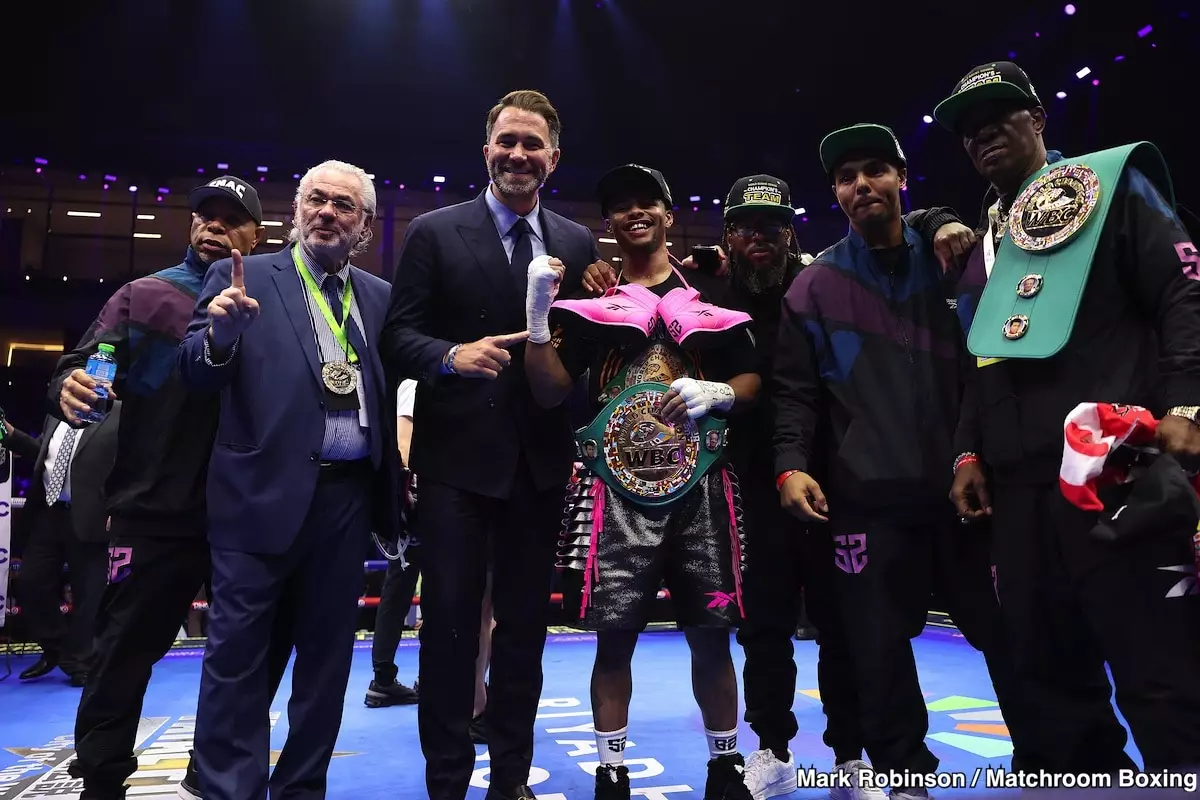In the world of boxing, decisions made by fighters can have a significant impact on their careers and legacies. The recent discussions surrounding Shakur Stevenson and his ties with promoter Eddie Hearn, as well as his potential shift to Lou DiBella, provide a fascinating case study. Stevenson, the WBC lightweight champion, has garnered attention not just for his skills in the ring but also for the strategic nature of his career decisions. As rumors swirl about his potential departure from Matchroom, the implications for both Stevenson and Hearn are profound and complex.
The Nature of Promoter Relationships
Eddie Hearn has openly navigated the intricacies of Stevenson’s contractual obligations. The mention of a “two-fight deal” moves beyond mere contractual language; it embodies the nature of loyalty versus ambition in the sport. Hearn’s reminder to DiBella about this commitment speaks volumes about the significance of understanding the fighter’s journey and the promoters’ role in it. Promoters aren’t just facilitators; they are partners in building a fighter’s legacy. Hearn’s attempt to solidify Stevenson’s allegiance highlights the ongoing tug-of-war between ensuring a fighter’s immediate financial security and nurturing their long-term career viability.
The reality of the boxing business, however, isn’t so straightforward. A fighter’s success can attract competing interests from various promoters, all eager to capitalize on newfound fame. Hearn’s assertion that he wants Stevenson to remain under his banner suggests a recognition that a talented fighter like Stevenson could soon become a prime target for rival promoters. Should Stevenson shine in his upcoming bout against William Zepeda—a fighter with a formidable record of 33-0 and 27 knockouts—the stakes for his future will skyrocket.
The Pressure of Expectations and Online Scrutiny
There’s more at play here than simply a conversation about contracts. The psychological dimension of boxing cannot be overlooked, especially when considering the immense pressure athletes face from fans and social media. Stevenson has been subjected to intense scrutiny, which Hearn criticizes as detrimental to mental health. The implications of losing in the ring could mean more than just defeat; they could weaken Stevenson’s marketability and jeopardize his future negotiations.
As Hearn pointed out, if Stevenson’s performance falters, the terms of future contracts may shift dramatically. The unthinkable scenario of Stevenson underperforming against Zepeda could lead to a drastic reevaluation of his worth in a sport that often discards athletes based on fleeting appearances and moments of vulnerability. This reality amplifies the stakes of his upcoming fight, as Stevenson may find himself wrestling not only with a formidable opponent but with the weight of expectation engraved by both the public and those within the boxing industry.
The Competitive Landscape of Modern Boxing
In today’s boxing environment, winning is the coin of the realm. Stevenson’s trajectory reflects the inherent volatility of the sport where fighters need to adapt to ever-changing dynamics. The prospect of aligning with different promoters offers a multitude of opportunities but also introduces substantial risk. Hearn’s candid comments underscore this duality; while he hopes to retain Stevenson, any misstep in the ring may encourage Hearn to reconsider that stance.
Moreover, Hearn’s perspective on “soft matchmaking” raises concerns about a fighter’s growth and resilience. The need to protect fighters, particularly those with specific vulnerabilities such as Stevenson’s reputed lack of knockout power, indicates an underlying anxiety. A fighter’s ability to contend with elite competition often hinges on how promoters navigate their careers, and Hearn’s acknowledgment of this reflects a broader trend in professional boxing.
The Tumult of Choice and Consequence
As Stevenson prepares for his bout with Zepeda, the conversation surrounding him continues to unfold dynamically. The apparent divide between maintaining loyalty to Hearn and exploring potentially lucrative opportunities with DiBella places Stevenson at a crossroads. This decision-making process is emblematic of a sport where each fight can pivot a career’s trajectory dramatically.
The role of social media amplifies the pressures surrounding this decision. Stevenson, witnessing the dichotomy of online criticism and adoration, contends with external voices that shape, for better or worse, public perception. Hearn’s insights into this phenomenon reveal the fraught relationship between athletes and their public personas, where the noise online has turned into an insidious force that can unmoor even the strongest of competitors.
As we watch this story develop, it becomes clear that Stevenson’s next steps will not simply define his career but will spotlight the deeper challenges inherent in navigating the competitive landscape of modern boxing. Each decision carries with it a legacy—the question remains: where will Stevenson choose to invest his future?

